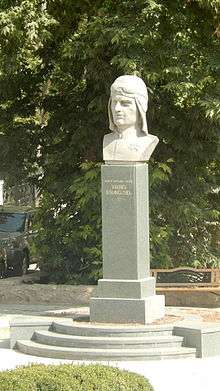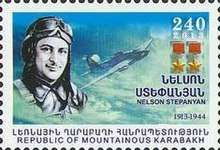Nelson Stepanyan
Nelson Georgievich Stepanyan (Armenian: Նելսոն Գևորգի Ստեփանյան, Russian: Нельсон Георгиевич Степанян; 28 March [O.S. 15 March] 1913 – 14 December 1944) was a Soviet Armenian Il-2 ground-attack aircraft pilot during the Second World War in the Red Air Force. He was twice awarded with the military title of the Hero of the Soviet Union, the highest military award in the Soviet Union.
Nelson Stepanyan | |
|---|---|
 | |
| Native name | |
| Nickname(s) | "Storm Petrel of the Baltic Sea" |
| Born | 28 March [O.S. 15 March] 1913 Shusha, Elisabethpol Governorate, Russian Empire |
| Died | 14 December 1944 (aged 31) Liepāja, Latvian SSR, Soviet Union |
| Allegiance | |
| Service/ | Soviet Air Force |
| Years of service | 1930–1944 |
| Rank | Lieutenant-Colonel |
| Unit | 2nd Air Squadron, 8th Air Brigade, 57th Division; 47th Fighter Division |
| Commands held | Guards unit 47th "Theodosia" Fighter Division |
| Battles/wars | Siege of Leningrad Baltic Offensive |
| Awards | Hero of the Soviet Union (twice)[1] |
Biography
Education
Stepanyan was born in Shusha (Shushi), Elisabethpol Governorate in 1913, but moved with his family to Yerevan at an early age. Nelson's father Gevorg Stepanyan was originally from Yerevan, and lived in a house on what is now Yekmalyan street in Yerevan. Nelson's mother originally was from Shusha. In 1911, Gevorg temporarily moved to Shushi, then the center of Nagorno-Karabakh, where he ran the Shusha office of the Singer sewing company. Soon after Nelson was born, the Stepanyans moved back to Yerevan. Stepanyan attended the Transcaucasian Preparatory Military School, graduating from there in 1930. He continued his studies at the Bataysk Military Aviation School, where he graduated from in 1935 and became a flight instructor at the school from then until 1938.[2]
Military service
Stepanyan was teaching at another military flight academy when Germany invaded the Soviet Union in June 1941. He volunteered for combat and participated in a multitude of aerial battles as a pilot of an Ilyushin Il-2 fighter bomber. Stepanyan took part in defensive battles at Poltava, Zaporozhye, Odessa, Kakhovka, and Mykolaiv. During his 20th departure Stepanyan was wounded by shrapnel flak. He defended the skies over Leningrad while he was a member of the 2nd Air Squadron, 8th Air Brigade, 57th Division.[2] After he was promoted to the rank of major in 1943, he became the commander of the 47th Fighter Division. With his unit, he took part in the Soviet offensives around Sevastapol, Theodosia, and Sudak (in the Crimea); for its efforts, the 47th Fighter Division was given the honorific title of Theodosia.[3] In May 1944, his fighter division returned to the Baltic and took part in several more battles against the Germans and the Finns.[2]
On 23 October 1942, the Supreme Soviet of the Soviet Union awarded Stepanyan with the title of Hero of the Soviet Union. In November, he became the commander of the 57th Assault Regiment. Stepanyan was later appointed commander of the Air Force courses of the Baltic Fleet, and then at the Higher Naval Air Force officer training, where he took part in skills training for aviation.
As of November 1942, Stepanyan was reported to have destroyed 78 German trucks, 67 tanks, 63 anti-aircraft guns, nineteen mortars, 36 railroad cars, twenty merchantmen and warships (including a destroyer), thirteen fuel tankers, twelve armored cars, seven long-range guns, five ammunition dumps, and five bridges.[4]
Stepanyan was also shot down over enemy lines, although friendly partisans aided him to reach back Soviet lines. Stepanyan was called "Storm Petrel of the Baltic Sea."[2]
During the Crimean Offensive in April 1944, Stepanyan was appointed commander of the 47th Fighter Division, who was fighting in the sky of the Crimea and Kuban. Under his command, the regiment participated in the battles of Sevastopol, Feodosia, and Sudak. Stepanyan had personally sunk three landing barges in one of his first combat missions. His plane was severely damaged on 22 May. Prior to the offensive, the 47th Division had destroyed 8 transports, 12 barges, 9 patrol boats, and more than 3,000 soldiers and officers.
In May 1944, after the liberation of Crimea, Stepanyan, with his 47th Fighter Division, returned to the Baltic Sea, where they were involved in the battles of the Gulf of Finland. On 22 July, he was awarded the Order of the Red Banner.

On his final sortie against Liepāja in the Latvian Soviet Socialist Republic on 14 December 1944, the assault group was attacked by German fighters. His plane was hit by anti-aircraft fire and though wounded, he rammed his own plane into a German warship.[2][5] He died along with navigator of the 47th Fighter Division Captain Alexander Rumyantsev. Stepanyan's loss devastated the rest of the men in the squadron. His fellow pilots sent the following letter to his parents after his death:
[Stepanyan was a] simple and modest man, close and beloved by all; he was a father and teacher to all of us, a friend and a commander....We all wept when Nelson Gevorgovich failed to return on that fateful day. They say that tears bring comfort. But the few tears of a soldier, like the red-hot drops of metal, burn the heart and call for vengeance.[6]
He was awarded the Hero of the Soviet Union title a second time posthumously for his sacrifice.
Soviet sources assert that Stepanyan undertook no less than 239 combat sorties, sunk 53 ships thirteen of which he did alone, destroyed 80 tanks, 600 armored vehicles, and 27 aircraft.[2]
Memory

In the Soviet Union, four statues were dedicated to him: one in Yerevan, the second in Liepāja, the third in Stepanakert and the last in his hometown of Shusha. The statue in Liepāja was going to be destroyed by the order of the new independent Latvian authorities, but was rescued by the Russian Navy. Located in Liepāja until the mid-1990s, it was transported to Kaliningrad and is now placed near the Baltic Fleet Naval Aviation headquarters in Kaliningrad, Russia. During the Soviet era, a large fishing trawler and Pioneer detachments were named after him.[2] Both the Soviet Union and Armenia issued postage envelopes and stamps with his image on them. On 8 May 2011, the eve of the 66th anniversary of the victory in the Great Patriotic War, Stepanyan was included on a monument in Ulyanovsk dedicated to pilots who were Heroes of the Soviet Union.[7] He also has streets named after him in Sevastopol and Feodosiya and schools named after him in Yerevan and Kirovabad.
Awards
- Twice Hero of the Soviet Union (23 October 1942 and 6 March 1945)
- Two Order of Lenin (9 June 1942 and 23 October 1942)
- Three Order of the Red Banner (24 November 1941, 21 October 1942, and 26 June 1944)
- Medal "For 300,000" kilometers in the air" of the GVF (6 December 1940)
- Medal "For the Defence of Leningrad"
- Medal "For the Defence of Odessa"
References
- Stepanyan was conferred with his second Hero of the Soviet Union, posthumously, on March 6, 1945.
- (in Armenian) Anon. «Ստեփանյան, Նելսոն Գևորգի» [Stepanyan, Nelson Gevorgi]. Armenian Soviet Encyclopedia. Yerevan: Armenian Academy of Sciences, 1985, vol. xi, p. 130.
- (in Armenian) Khaleyan, Yervand M. "Սովետական Հայաստանը Հայրենական Մեծ Պատերազմի Հաղթական Ավարտի Շրջանում" [Soviet Armenia in the Final Victorious Stage of the Great Patriotic War] in Hay Zhoghovrdi Patmut'yun [History of the Armenian People]. Yerevan: Armenian Academy of Sciences, 1970, vol. 8, p. 126.
- "What Can One Man Do?" Time Magazine. November 16, 1942. Retrieved 23 May 2006.
- [German records show four transport SS Mina Cords; SS Otterberg; SS Clara L. M. Russ; SS Erika Schunemann and one tanker [SS Inka] vessels lost in two raids on Liepāja; however they do not confirm any plane hitting a ship
- The pilots who wrote this letter were, among others, airmen Fokin, Lazarev, Klimov, Skayev, Popov, Udaltsov: Khaleyan. "Soviet Armenia", p. 130.
- Губернатор Ульяновской области Сергей Морозов принял участие в открытии памятника Героям Советского Союза в Ульяновском высшем авиационном училище гражданской авиации (in Russian). Aviaport.ru. 10 May 2011. Retrieved 8 November 2013.
- Simonov & Bodrikhin 2017, p. 342.
Bibliography
- Simonov, Andrey; Bodrikhin, Nikolai (2017). Боевые лётчики — дважды и трижды Герои Советского Союза [Combat pilots - Twice and thrice Heroes of the Soviet Union]. Moscow: Russian Knights Foundation and Vadim Zadorozhny Museum of Technology. ISBN 9785990960510. OCLC 1005741956.CS1 maint: ref=harv (link)
External links
| Wikimedia Commons has media related to Nelson Stepanyan. |